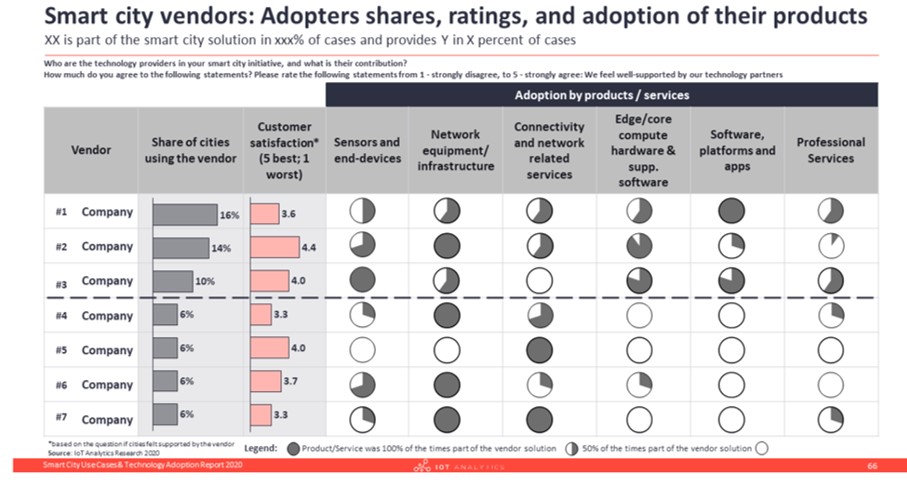Two important reports about the market and vendors of smart cities help understand a gap related to the supply chain of smart cities. The first is the Frost & Sullivan report “Smart Cities – Frost & Sullivan Value Proposition” [1]. The second is the IoT Analytics report “Smart City Use Cases & Technology Report 2020” [2].
Frost & Sullivan has defined a smart city as one that has an active plan and projects in at least five of the eight functional areas (verticals) of Energy, Buildings, Mobility, Technology, Infrastructure, Healthcare, Governance, and Citizens. Each of these areas has specific components that define the ‘Smartness’ of the City. In the description of what is inside the verticals, digital technologies prevail (e.g. smart grids, smart meters, broadband, sensor networks, digital management, e-services) with a few additions for technologies related to renewable energy and transport (Figure1).
Figure 1: Frost & Sullivan key technologies, products and services per smart city vertical
The report of IoT Analytics analyses the level of adoption of 31 smart city use cases across 5 main verticals. It is based on a survey of 50 city decision-makers from the world’s leading Smart City initiatives. It classifies the smart city vendors in 6 categories of products and services providers: (1) sensor and end-devices; (2) network equipment and infrastructure; (3) connectivity and network related services; (4) edge/core compute hardware and software; (5) software platforms and apps; and (6) professional services (Figure 2).
Figure 2: IoT Analytics: Smart city vendors
Both reports shed light on technologies, products, services for the making of smart cities. However, in both cases, the smart city supply chain and the city ‘smartness’ is defined mainly by providers of digital technologies and services. The question is how accurate is this smart city supply chain delimitation, and what are the implications of this definition on the value chain and impact of smart cities? [3]
It seems that the definition of the supply chain of smart cities by digital technologies, products and services is accurate but extremely narrow at the same time. It only records suppliers of the digital components / dimension of smart cities. The following figure 3 can help explain this point of view: at the left side are the verticals and layers of a smart city (physical space layer, innovation space layer, digital space layer), while at the right side is the digital layer and its components as defined by ITU-T FG-SCC [4].
Figure 3: Physical, institutional, digital layers of smart city and structure of the digital layer
Looking into the details of the smart city digital layers (fig. 3-right) we find components such as sensing, network, connectivity, compute and data, software applications, and we realise their full coincidence with the categories of smart city vendors described in the IoT Analytics report and the key parameters of the city ‘smartness’ described in the Frost & Sullivan report. Thus, what the reports of Frost & Sullivan and IoT Analytics describe is the supply chain of the digital layer of the smart city rather than the supply chain of the smart city. And the difference is huge.
The smart city supply chain, in addition to providers and sellers of digital products and services, also includes suppliers offering engineering, building technologies, new construction materials, urban infrastructure developers, and many providers offering services related to city planning and design, consulting, environmental sustainability, innovation and knowledge management, civil services, finance, standards and regulations, civic organizations, and more. Figure 3 shows that smart cities comprise components far beyond digital technologies and broadband services. Rules and regulation institutions are equally important to digital technology. The same goes for context and skills. The city and the smart city is not an object, but a complex system emerging from a million individual actions of citizens and producers, which city planning attempts to coordinate and give coherence. The smart city, like any city, is not just about improving infrastructure, transport and utilities. It is a cyber-physical engine for optimization / innovation of any human activity. (If you want to play good chess, play from your smart city).
Some complex and very effective smart city projects illustrate the difference between the digital space of the smart city and the full smart city space. This is the case for instance of Vision Zero, a combination of engineering, design, training, law enforcement and digital technologies to eliminate all traffic fatalities and severe injuries in cities or Positive Energy Districts, which combine smart technologies, building technologies, spatial, regulatory, financial, legal, social and economic interventions towards annual net-zero energy import and net-zero CO₂ emissions.
Reducing the smart city supply chain to vendors of digital technologies, services and products, is equal to reducing the impact of smart cities. In smart transport solutions, for instance, the combination of Intelligent Transport Systems with traffic regulations has led to a much greater reduction of absolute traffic and particle emissions compared to digital solutions alone [5].
Robert Bell expressed very well the shared opinion that smart cities technological endeavour have not produced yet significant results, saying “Sorry Smart Cities – You Completely Missed the Point”: “Technologies have been developed to improve how cities manage everything from energy, water, public safety and pollution to transportation, healthcare and tax collection. Consultants have prospered, IT systems sales have grown and CIOs have earned new respect. Now, after more than two decades of smart cities adoption, what do we have to show for all that investment? We get a 5% increase in efficiency, a 10% reduction in costs, a 30% drop in time wasted looking for a parking spot. Wow. We do also sometimes save lives thanks to more efficient policing, firefighting and emergency response. So, aside from saving those lives, what difference have smart cities made to their citizens? Are they enjoying more freedom, more opportunity, greater prosperity or stronger connection to the community and its culture because they live in a smart city?” [6].
Different designs are needed and more complex supply chains integrating digital and non-digital components. In the end, it is about the supply chain: you get what you give.
References
- Frost & Sullivan (2019). Smart Cities – Frost & Sullivan Value Proposition. https://ww2.frost.com/wp-content/uploads/2019/01/SmartCities.pdf
- IoT Analytics (2020). Smart City Use Cases & Technology Report 2020. https://iot-analytics.com/product/smart-city-use-case-adoption-report-2020/
- The supply chain is the interconnection of all the functions from the manufacturing of raw material into the finished product and ends when the product reaches the final customer. The supply chain is a product-based / operations-based perspective. Value Chain, on the other hand, is a set of activities that focuses on creating or adding value to the product. The value chain is a value-based perspective to gain a competitive advantage, primarily concerned with providing value for price product or service. (See also, https://keydifferences.com/difference-between-supply-chain-and-value-chain.html).
- ITU-T FG-SCC (2015). Setting the framework for an ICT architecture of a smart sustainable city. Focus Group Technical Specifications. http://www.itu.int/en/ITU-T/focusgroups/ssc/Documents/website/web-fg-ssc-0345-r5-ssc_architecture.docx
- Egeler, C. and Dell, G. (eds) (2013). Best Practices in Urban ITS. Collection of Projects. Version 1.0. Urban ITS Expert Group”.
https://ec.europa.eu/transport/sites/transport/files/themes/its/road/action_plan/doc/2013-urban-its-expert_group-best-practice-collection.pdf - Bell R. (2020). Sorry Smart Cities – You Completely Missed the Point.
https://www.intelligentcommunity.org/sorry_smart_cities_you_completely_missed_the_point




